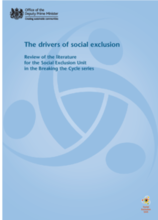This document is a literature review for the purpose of determining the drivers of social exclusion. Its objectives were to: 1) determine the current drivers; 2) determine emerging drivers that might have a future impact on social inclusion; 3) Assess the relative strength of drivers.
The review covers the following subjects: a) income and poverty; b) employment; c) education and skills; d) health; e) housing; f) transport; g) crime and fear of crime; h) social support/social capital; i) impact of the neighborhood.
The study found that households with relative low income were more likely than others to be socially excluded on all dimensions except isolation and lack of support. The study found clear evidence that poverty was associated with a) post neonatal and child mortality; b) low birth weight; c) some congenital anomalies; d) most infectious diseases; e) poor dental health; f) obesity and poor diets; g) physical activity; h) physical abuse; i) teen pregnancy; j) poor environment and housing conditions; k) homelessness; l) poor educational attainment; m) youth suicide; n) mental illness.
The study further determined that employment status and family type are drivers of low income. The study stated that single and childless couples on Job Seekers Allowance Income Support and families with children and pensioners who are entitled to benefits, but not claiming them had the largest income gaps. Those who are poor for a long time and often are most risk of social exclusion. Women and children, and those living in lone parent and single pensioner families are most at risk of persistent low income.
The study notes that there is a clear commitment to address child poverty; however, further policy measures are needed.

